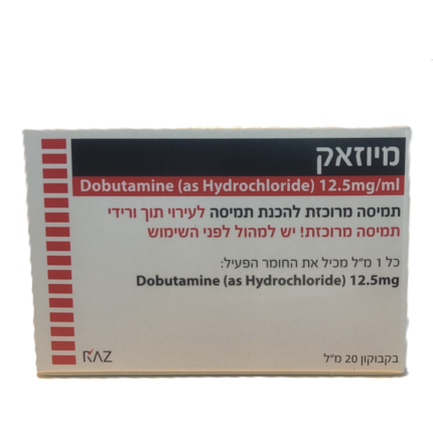Quest for the right Drug

מיוזאק MIOZAC (DOBUTAMINE AS HYDROCHLORIDE, DOBUTAMINE HYDROCHLORIDE)
תרופה במרשם
תרופה בסל
נרקוטיקה
ציטוטוקסיקה
צורת מתן:
תוך-ורידי : I.V
צורת מינון:
תרכיז להכנת תמיסה לאינפוזיה : CONCENTRATE FOR SOLUTION FOR INFUSION
עלון לרופא
מינוניםPosology התוויות
Indications תופעות לוואי
Adverse reactions התוויות נגד
Contraindications אינטראקציות
Interactions מינון יתר
Overdose הריון/הנקה
Pregnancy & Lactation אוכלוסיות מיוחדות
Special populations תכונות פרמקולוגיות
Pharmacological properties מידע רוקחי
Pharmaceutical particulars אזהרת שימוש
Special Warning עלון לרופא
Physicians Leaflet
Special Warning : אזהרת שימוש
4.4 Special warnings and precautions for use During the administration of MIOZAC solution, as with any other adrenergic agent, the ECG and blood pressure must be continuously monitored. In addition, whenever possible and for the purpose of a safe and effective infusion of MIOZAC solution, pulmonary capillary pressure and cardiac output should be monitored. Hypovolemia must be appropriately corrected before starting treatment with MIOZAC solution. Animal studies indicate that MIOZAC solution may be ineffective if ß-blocking drugs have been recently administered. In this case, the peripheral vascular resistance can increase. No improvement can be observed in the presence of marked mechanical obstruction, such as in severe aortic valve stenosis. Dobutamine, likewise other ß2-agonists, can cause a modest reduction in serum potassium without reaching or rarely reaching, hypokalaemia levels. It is therefore recommended to monitor potassium during therapy with MIOZAC solution. Stress cardiomyopathy (Takotsubo syndrome) is a possible severe complication of the use of dobutamine during stress echocardiography (see section 4.8). The administration of dobutamine for stress echocardiography should be only undertaken by a physician experienced with the procedure. The physician should be vigilant during the test and the recovery period and be prepared for appropriate therapeutic intervention during the test. In the event of stress cardiomyopathy (Takotsubo syndrome) dobutamine should be stopped immediately. Use after acute myocardial infarction Clinical experience with MIOZAC solution after acute myocardial infarction is insufficient to establish the safety of the drug for this use. It is known that any pharmacological agent capable of increasing the contractile force of the heart and its frequency can cause an increase in the infarcted area, but it is not known whether this can also occur with Dobutamine. Increase in heart rate and arterial pressure MIOZAC solution may provoke a considerable increase in heart rate or arterial pressure, especially systolic. In clinical studies, approximately 10% of patients experienced rhythm increases of 30 beats/min or more, and approximately 7.5% experienced increases in systolic blood pressure of 50 mmHg or more. All these effects may generally be decreased or eliminated with the decrease in the dosage. Because Dobutamine facilitates atrioventricular conduction, patients with atrial fibrillation are at risk of developing a rapid ventricular response. Previously hypertensive patients are at the highest risk of an exaggerated blood pressure response. Ectopic activity MIOZAC solution can precipitate or aggravate ectopic ventricular activity but has rarely caused ventricular tachycardia. Hypersensitivity Hypersensitivity reactions associated with the administration of MIOZAC solution have occasionally been reported, including skin rash, fever, eosinophilia, and bronchospasm. Important information about some of the ingredients: The product contains sodium metabisulphite: this substance may rarely cause severe hypersensitivity reactions and bronchospasm. Each vial contains less than 1 mmol (23 mg) of sodium, that is to say essentially ‘sodium-free’.
Effects on Driving

שימוש לפי פנקס קופ''ח כללית 1994
לא צוין
תאריך הכללה מקורי בסל
לא צוין
הגבלות
לא צוין
מידע נוסף
